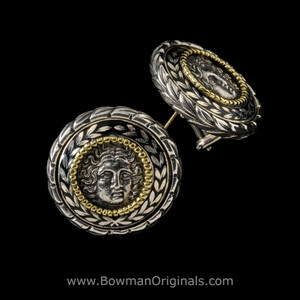At the hush between night and morning, when the Aegean looks like hammered glass, the Sun God gathers the day into his hands. Helios rises from the edge of the world—born of light itself, child of Hyperion and Theia, brother to Eos, the rosy Dawn, and Selene, cool-faced Moon. Where his sister lifts the first pale ribbon of color and his other sister steadies the night, Helios takes the long, bright labor in between.
He mounts his golden car, harnessing fire-maned horses, and the sky becomes a road. Hooves strike sparks from the horizon; wheels hum over blue and cloud. With this daily crossing, Helios makes the measures by which mortals live—opening markets, guiding sails, warming fields, waking stones into color. By evening he has poured the entire cup of daylight, drop by radiant drop, across islands and continents and the uncounted smaller lives that look up and call it morning.
Because he travels the whole vault of heaven, Helios sees everything. The poets call him an all-seeing witness, one to whom oaths are sworn and secrets laid bare. It is Helios who tells Hephaestus of the hidden affair, Helios who shows Demeter the truth of Persephone’s descent. His vision is not merely light but knowledge: a clarity that exposes what is and asks the world to answer for it.
Myth wraps him in stories that flare like sunlit spray. There is the caution carried by Phaethon, the rash son who begged to steer the chariot for a single day. He grasps the reins, the horses surge, the path is lost; mountains scorch, rivers steam, constellations scatter. A thunderbolt ends the fall. In this tale, Helios stands as the measure between daring and hubris, the disciplined mastery that keeps brilliance from becoming ruin.
There is the island of sacred cattle—the herds of Helios, sleek and inviolate, grazing under watchful eyes. Odysseus’s weary crew, driven by hunger, break the taboo, and the Sun God calls upon Zeus for justice. The sea heaves; the ship shatters. To wrong Helios is to trespass against the very order by which day is kept: a reminder that light is gift and law at once.
At sunset, ancient singers say, Helios does not vanish—he sails home. The world’s rim becomes a dark-flowing river, and he crosses it in a golden cup, a great gleaming bowl that bears him back to the dawn-gate for tomorrow’s ascent. It is a small, perfect image of the cycle he commands: light emptied, light restored. Night is no defeat, only the journey back to the source.
Cities, too, once offered him their devotion. Rhodes—sun-washed and sea-bounded—called Helios its patron and raised a wonder in his honor. Horse races, bright coins, hymns of praise: all in thanksgiving for clear weather, fertile season, safe return. In some ages, Helios and Apollo mingle like sun on water, the physical sun and the music of light speaking with one voice. In others, Helios stands apart—pure radiance, visible and absolute.
What makes his story endure is its simple, inexhaustible truth: every dawn is a promise kept. Helios is the embodiment of renewal—the courage to begin again, the steadiness to continue, the warmth that coaxes color from the world. He is also measure—of hours, of effort, of the right distance between flame and form. And he is witness—the gaze that clarifies, the bright conscience of sky.
Listen at first light and you can almost hear the harness rings, the breath of living fire, the hush before motion. Then the wheels turn, and roofs, leaves, waves, faces ignite. By noon he is a high held note; by evening he pours out the last gold over fields and harbors. Night deepens, and somewhere beyond the western rim a quiet oar dips into a celestial river—the Sun God returning, faithful to the circuit, intent on tomorrow.
So the old hymns still make sense: hail the charioteer who carries the day; hail the eye that sees; hail the warmth that ripens and the clarity that reveals. In Helios, myth gives the sun a voice—and with it, a lesson: let your light be steady, your course sure, your radiance generous.








